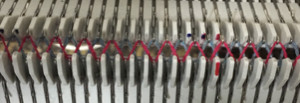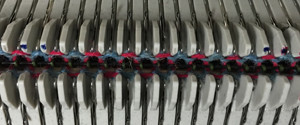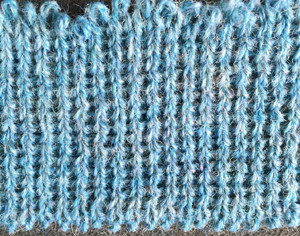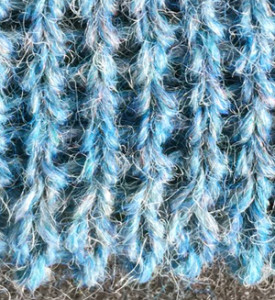Depending on the sort of rib, the beds need to be aligned in most instances so that the needles on opposing beds line up between each other. For this ribber cast on the beds start at full pitch, as you would for EON knitting. Every other needle is brought in to work. A first “zigzag” row is created at the tightest tension possible. On the second row, the alternative needles need to be worked. On Passap E6000 BX, LX with pushers under new needles only will help do the job. On Japanese machines: bring the new needles out to hold, set both carriages to slip. This will result in only those “new” needles knitting on the next pass. The outcome will be one zigzag crossing over the other (red over blue in the photo). Prior to the third knit row, reset the carriages or locks for circular settings (CX/CX, opposite part buttons). Because all stitches will be knitting on each bed, loosen the tension to about three-quarters of the rib stitch size, knit two rows, change racking handle/lever and needle positions to half pitch at their completion. Adjust tension to desired rib stitch size, knit a closing “zigzag” all knit row at tension used for the remaining knit, and proceed in rib
The method may be used both for every needle and for every other needle rib.
The configurations for each, colors are in reverse order from photos that follow 

first zigzag row second zigzag row (contrast color for illustration purposes)
second zigzag row (contrast color for illustration purposes) hang comb, knit 2 circular rows
hang comb, knit 2 circular rows  change racking position and needles alignment
change racking position and needles alignment  change tension, continue in rib, knitting all sts both beds
change tension, continue in rib, knitting all sts both beds  detail close up
detail close up 